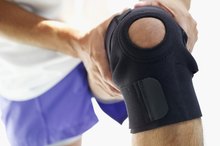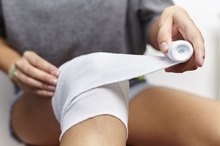What is the Strayer Procedure?
The Strayer procedure, also known as gastrocnemius recession, is a treatment option for people who have gastrocnemius equinus contracture. The name equinus contracture is take from the position of horses' ankles, which are pointed down. A gastrocnemius equinus contracture is a medical disorder that causes tension in the calf muscle. To correct this condition, doctors must perform a Strayer gastrocnemius procedure.
Significance
Gastrocnemius contractures are thought to happen from hereditary, aging and medical conditions. A gastrocnemius equinus contracture is not being able to move the ankle joint beyond a neutral position while the knee is straight. Many people automatically compensate for a contracture by maintaining movement through the joints before the ankle. In some cases, regular stretching of the calf can treat and diminish these symptoms naturally.
Procedures
Rehab Exercises After MCL Injury
Learn More
The Strayer procedure involves releasing the gastrocnemius tendon to lengthen the calf muscle. The surgeon cuts an opening on the back part of the lower leg and the gastrocnemius tendon is uncovered. The tendon is released and sutured to the tissue lying under the stretched location.
Recovery
After the Strayer procedure, a patient normally will need two to six weeks to recuperate. The patient will have to wear a brace or cast for about two weeks. In the beginning, there will be much pain in the calf, but then the pain will decrease. The calf has to be strengthened after the pain has decreased. Individuals generally can walk in six to eight weeks. A patient may need a year to regain 95 percent of the original calf strength.
Considerations
Exercises for a Torn Quad
Learn More
After a Strayer procedure, a patient may experience skin bonding, injury to the sural nerve, scarring and calf weakness. The skin incision may develop links to the tissue lying over the calf muscle.This will cause bonding of the skin whenever the calf muscles move. But early in the post-operative stage, deep muscle massaging can break those bonds. The sural nerve is capable of being directly wounded because its position is near the site of the operation.
Improvements
Correctly pinpointing and protecting the sural nerve is an important component of the procedure. Awareness of the important structures connected with the Strayer procedure should allow surgeons to reduce the amount of sural nerve damages and improve the appearance of the surgical incision by decreasing the length.
Related Articles
References
Resources
Writer Bio
J.R. Penn is currently attending Southeastern Louisiana University, where she is pursuing a master's degree in communication and sciences disorders. Penn volunteers in many community outreach organizations. She helps encourage individuals by giving them the tools and confidence necessary to be successful in their everyday lives. She has been a writer since 2004.









